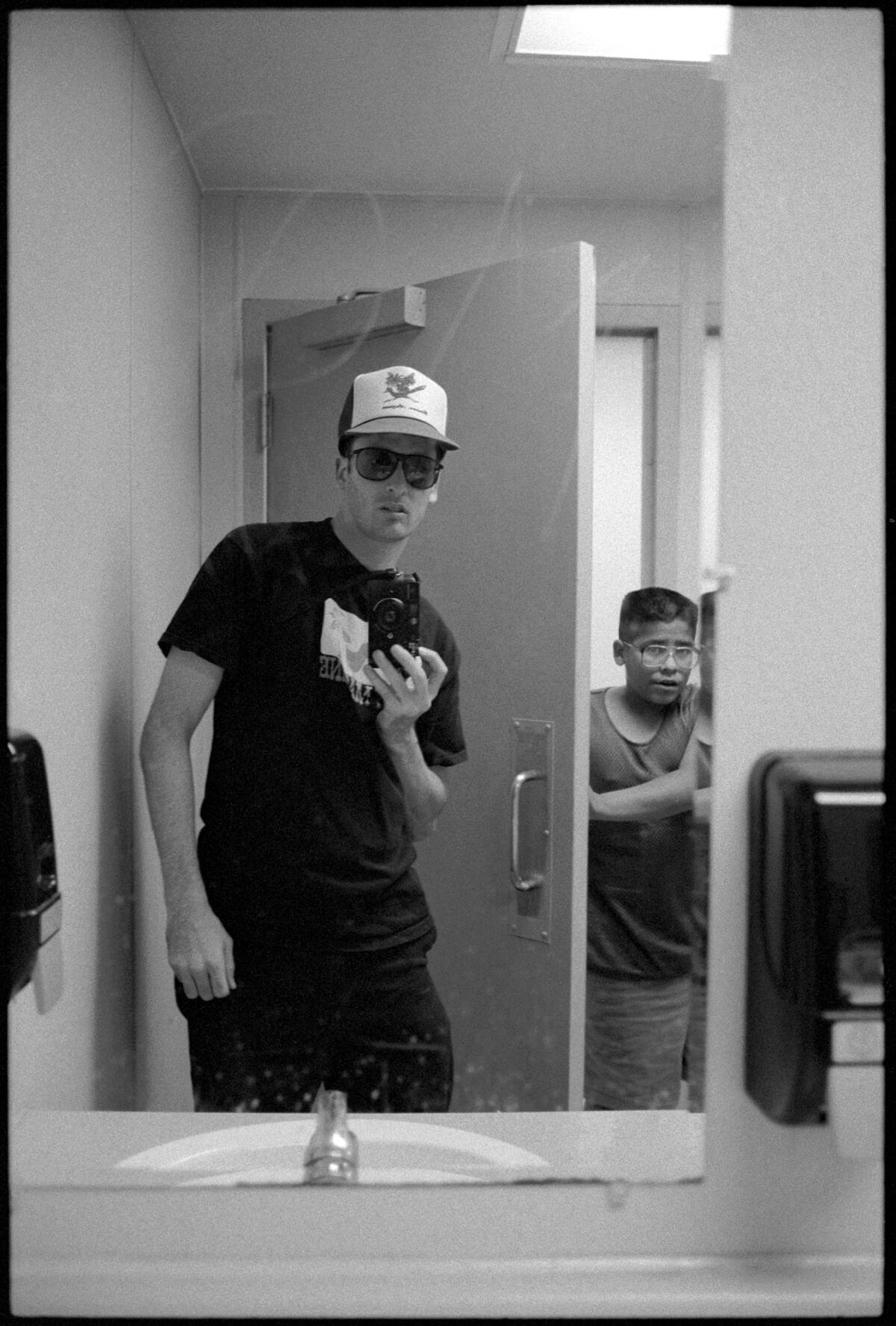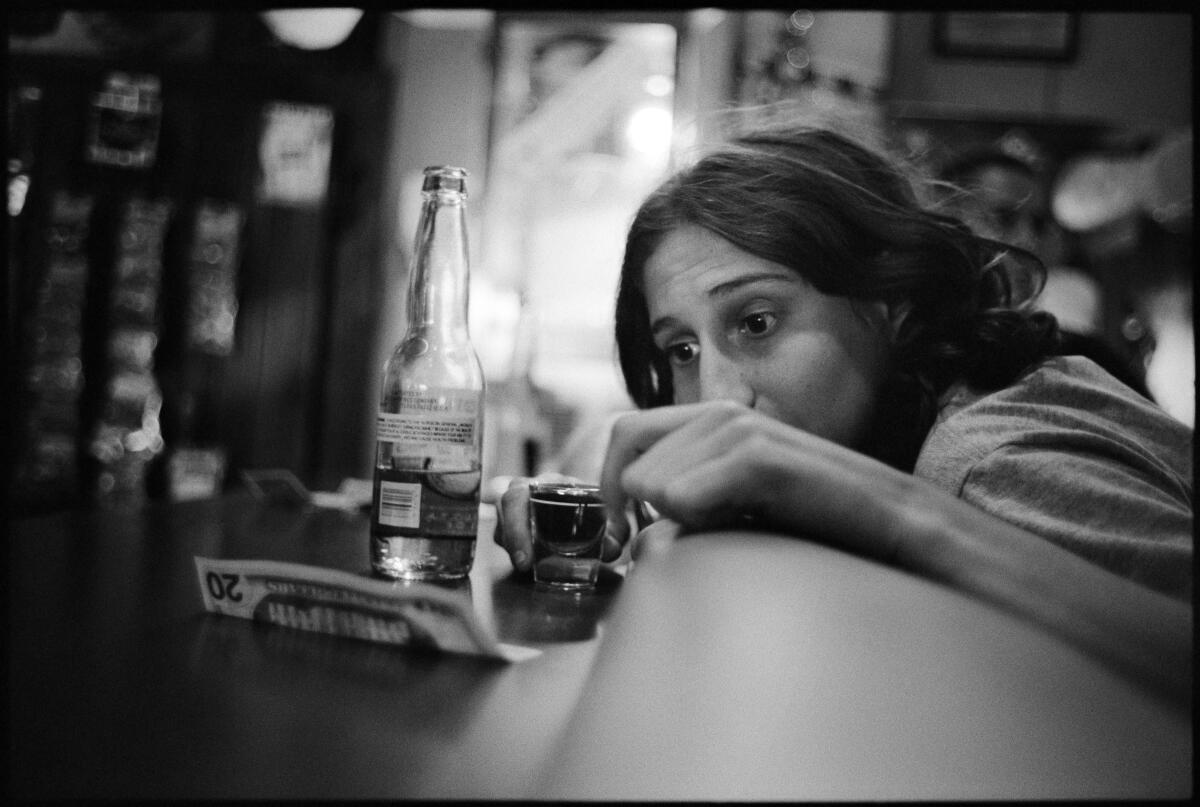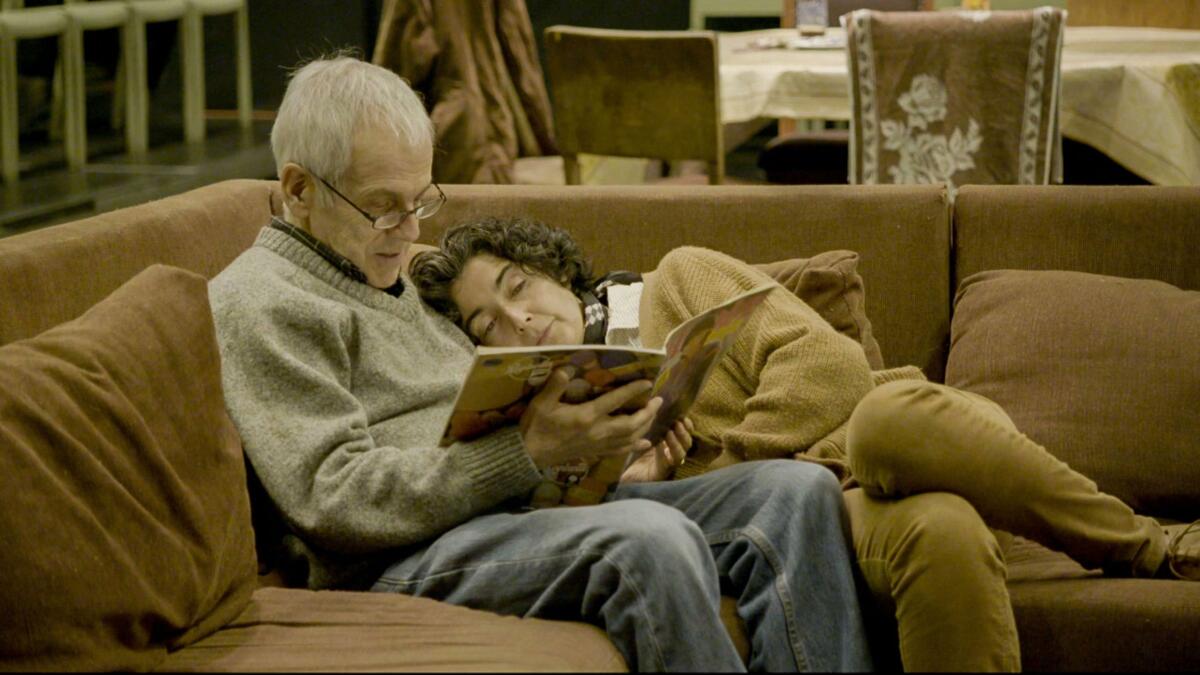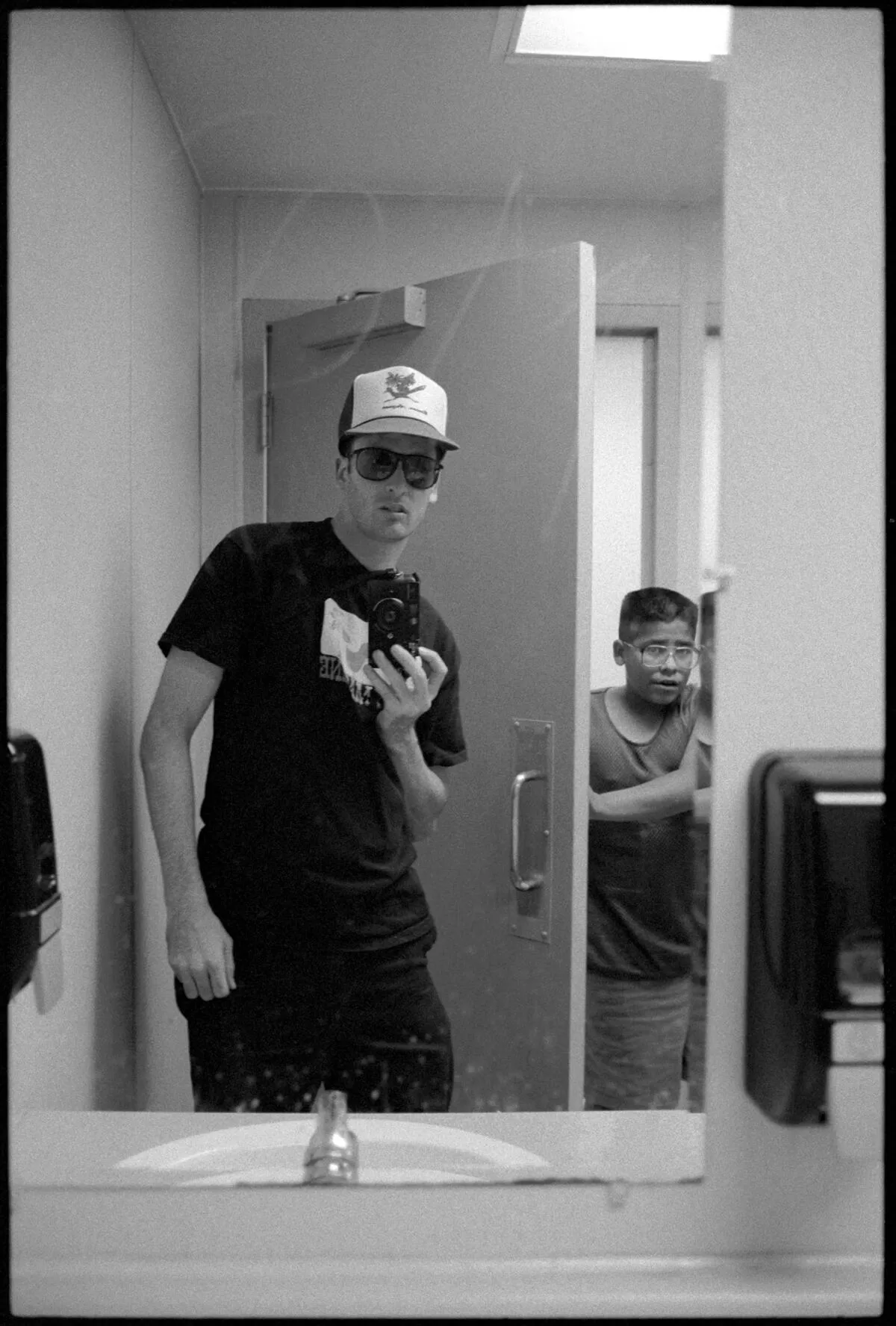Skate or die
You may know Ed Templeton as a painter. (He is part of the stable of artists at Roberts Projects on La Brea.) You may know him as a photographer. (His images of punks, weirdos and burnouts in the environs of Huntington Beach appear regularly in exhibitions and surface regularly on his Instagram, @ed.templeton.) You may also know him from his appearance, with Deanna Templeton, a fellow artist and his wife, in “Beautiful Losers,” a 2008 documentary directed by Aaron Rose and Joshua Leonard that chronicled the scene around the Alleged Gallery in downtown Manhattan in the 1990s. The film spawned a related exhibition and catalog.
In addition to all of these various roles, Templeton, in the early 1990s and early 2000s, was a professional skateboarder. And throughout those years, he was never without a 50-millimeter camera.

Ed Templeton, “Self-Portrait, Texas,” 1998.
(Ed Templeton)
Dozens — possibly hundreds — of his photographs from that era are now on view at the Long Beach Museum of Art, in the solo exhibition “Wires Crossed: The Culture of Skateboarding, 1995-2012,” which is on view through early May. The show follows the publication, last year, of a similarly titled book by photo stalwarts Aperture that likewise features many of these images. Kelefa Sanneh, in the New Yorker, described it as “unsparing but nonjudgmental.”
The same could be said for the exhibition, which captures a moment — largely prior to the saturation of social media platforms like Instagram (which launched in 2010) — in which subcultures could still largely remain subcultures without turning into viral fodder.
In clear-eyed ways, Templeton captured the messiness of his milieu: a destructive yet charming crew of skate punks with whom he inhabited a van and uninspiring motel rooms to stage professional demos and promote his skate line, Toy Machine (which is still going).
Newsletter
You’re reading Essential Arts.
Carolina A. Miranda guides you through the depth and breadth of Southern California’s complex cultural sphere.
You may occasionally receive promotional content from the Los Angeles Times.
In his photographs, which are largely black-and-white, you’ll see skaters scoring weed, having sex, showing off their bruises and generally demonstrating little regard for authority. Skating enters the picture — including elegant scenes in which bodies sail choreographically along drainage pipes and hand rails. (I’ve always been intrigued by the ways that skaters, like graffiti artists, make such imaginative use of forgotten bits of infrastructure.) But the show is less about skating than everything that surrounds it — toxic and not.
Photographs reveal androgynous innocence and weary worldliness. Templeton captures the reeling gaze of skaters in the wake of traumatic injuries. This includes an image of Templeton himself, in a photo by Patrick O’Dell, that shows him bloodied and in shock, a set of arms gently swaddling his injured head with a T-shirt. These images have all the drama of paintings of Catholic martyrdoms.
Particularly compelling are the sensitively made photographs of Elissa Steamer, who was often the lone woman on these tours. Templeton captures her toughness but also moments of intense vulnerability.

Ed Templeton, “Elissa Belly Up to the Bar, Kent, Ohio,” 1999.
(Ed Templeton)
The artist adds a layer of intimacy to these photographs by drawing and painting on their surface, often adding text entries that transform the pictures into a diary. Moreover, the thoughtful installation clusters photographs in digestible arrangements, with hand-drawn maps by Templeton articulating the various journeys he and his band of outsiders survived.
“Wires Crossed” is about punks being punks. It’s also about camaraderie and friendship and love amid truly chaotic circumstances — not to mention a singular lens into a sport and a culture that was birthed and nurtured in Southern California.
Ed Templeton, “Wires Crossed: The Culture of Skateboarding, 1995-2012,” is on view at the Long Beach Museum of Art through May 5; lbma.org.
On the stage
The musical “The Wiz” is ending its 13-city tour at the Hollywood Pantages Theatre, and culture writer Ashley Lee had a look at how the economics of revivals have changed. The show, rather than going on tour after a Broadway run, has turned the model on its head by touring first, after which it will play a limited run on Broadway. “It’s different, but not unprecedented,” producer Mike Isaacson tells Lee. “Broadway and the road have gone through different eras and phases, and it will continue to morph, but we may be beginning a chapter of something new.”

Wayne Brady as the titular Wiz.
(Jeremy Daniel)
Times theater critic Charles McNulty had a look at the show to see how this new revival holds up. He found some powerful singing and the joy of familiar numbers. Actor Nichelle Lewis, he writes, “makes a sweetly sad yet still spirited Dorothy,” and she has “a voice that can sweep the heavens.” But the production “leaves an overall impression of having been produced rather than directed.”
Two plays by writers with television backgrounds are currently onstage in L.A.: “Mercury,” by Steve Yockey, a surreal, supernatural thriller that shows that the ’burbs are more than they may seem, and “Middle of the World,” by Juan José Alfonso, a political drama about an ousted Ecuadorean president who finds herself driving for Uber in New York. Both shows, writes McNulty, “spin yarns that travel to places the theater isn’t accustomed to visiting.”
In and out of the galleries
Painter Joey Terrill is currently the subject of a solo show at Marc Selwyn Fine Art in Beverly Hills. On view are works drawn from the artist’s still-life series: intimate domestic scenes inspired by Pop Art about the artist’s own life and his 1989 HIV diagnosis. I spoke with Terrill about making art about AIDS that is not about death. “There’s been art against the government, art about grieving, the sadness, the anger,” he tells me. “And I have this ambivalence about the fact that I am alive and the pharmaceutical industry is reaping billions.”

The work of Joey Terrill (in his Boyle Heights studio) has been ascendant as of late.
(Jason Armond / Los Angeles Times)
Painter and critic Laurie Fendrich writes about the scandalous cancellation of “Three American Painters: Then and Now” at the Santa Barbara Museum of Art. “An abrupt cancellation of any serious scholarly exhibition is a gross violation of a museum’s obligations to the curators, lenders, and writers involved in preparing it,” she writes, “not to mention the museum’s responsibility to visitors to not jerk them around.”
At the Cheech in Riverside, a 50-year survey of L.A. painter Judithe Hernández is currently on view. The show includes dreamy mystical pieces that reimagine female archetypes and comment on the brutal treatment of women. “First, a feminist framework structures everything,” writes Times art critic Christopher Knight of the exhibition. “Second, drawing is fundamental. The exhibition demonstrates, as if proof were needed, that social activism and individual artistic freedom are anything but incompatible.”

Judithe Hernández, “Soy la Desconocida,” 2022.
(Riverside Art Museum)
At Leica Gallery in West Hollywood, celebrity photographer Mathieu Bitton is displaying images taken in his native Paris. The show features images of celebrities such as Lenny Kravitz and Mick Jagger but also includes city scenes taken over the last decade. Contributor Pamela Chelin has all the deets.
A Millard Sheets mural created for a Santa Monica branch of a Home Savings and Loan now graces the façade of the Hilbert Museum of California Art in Orange.
Culture and tech
The Times’ Deborah Vankin has an absolutely wild story about finding her obituary online — even though she is very much alive. It’s part of a tactic to generate SEO-friendly content that can reap advertising revenue. “What these content farms do is monitor SEO and Google inputs all day and if they see a breakout, they seize on that and publish hoaxes as clickbait content,” says McKenzie Sadeghi of NewsGuard, a misinformation watchdog. “It all comes down to financial revenue. Capitalize on search results — what people are interested in — and publish fake news around that to direct people to their site and, in turn, get money for advertising.”
Enjoying this newsletter? Consider subscribing to the Los Angeles Times
Your support helps us deliver the news that matters most. Become a subscriber.
Mia Sato at the Verge also has a story about how AI-generated obituaries have become a clickbait scourge.
Former Times tech columnist Brian Merchant writes about the torching of a Waymo driverless taxi in San Francisco last week. “Pyrotechnic demolition can be seen as the most dramatic act yet in a series of escalations — self-driving cars have been vocally opposed by officials, protested, ‘coned,’ attacked, and, now, set ablaze in a carnivalesque display of defiance,” he writes. “The Waymo torching did not take place in a vacuum.”
Classical notes
It is the 100th anniversary of George Gershwin’s “Rhapsody in Blue” and the critics are weighing in. At the New York Times, in a piece that has everyone talking, pianist and composer Evan Iverson described it as “The Worst Masterpiece,” arguing that the composition has overshadowed the music it drew from: Black traditions of jazz and swing.
New York Times opinion writer John McWhorter disagreed. “The rhapsody lacks both the heft of Mahler in a classical direction and the funk of Mingus in a jazz one,” he writes, “But Iverson’s charge that it is ‘cheesecake’ — as in too immediately likable to be serious work — is a risky form of judgment.”
Tom Huizenga at NPR gets into how “Rhapsody” was received by critics when it first landed (not well) and what it represented socially and politically — a fusion of different cultures — and how that has been received and reinterpreted by musicians since. The L.A. Times’ Gustavo Arellano notes that it is precisely its themes of union that make it important in this day and age.
Need more? Jazz critic Nate Chinen and curator and host Greg Bryant have a very thoughtful convo on the subject on the WRTI podcast “The Late Set.”

George Gershwin in 1937.
(Associated Press)
Around the culture
In his day, Chilean journalist Augusto Góngora was known for his clandestine broadcasts during the Pinochet dictatorship. The Chilean documentary “The Eternal Memory” (“La memoria infinita”) tracks the story of how he slips into the grips of Alzheimer’s. The film may seem to be a story about one man’s loss of his memory, but it’s also about the histories we choose to remember and those we try to forget.
Contributor Carlos Aguilar spoke with director Maite Alberdi about her work on this affecting, poignant film.

Augusto Góngora, left, and his wife, Paulina Urrutia, in “The Eternal Memory.”
(Sundance Institute)
Plus, Times critic Robert Abele watched all the Oscar-nominated short films so you don’t have to.
Essential happenings
Matt Stromberg at Hyperallergic reports on a new festival at Crenshaw Dairy Mart devoted to showcasing the work of filmmakers of color.
Moves
Essence Harden and Paulina Pobocha have been named curators for the Hammer Museum‘s 2025 “Made in L.A.” biennial.
Solveig Nelson has joined the Benton Museum at Pomona College as curator of photography and new media.
The San Francisco Ballet received a $60-million donation — the largest in its history — from an anonymous donor described as a longtime supporter.
Collector and philanthropist Estrellita B. Brodsky has been elected board chair of the Hirshhorn Museum in Washington, D.C.
Passages
Seiji Ozawa, the kinetic conductor who led the Boston Symphony Orchestra for three decades, has died at the age of 88. For a time, in the 1970s, he also led the San Francisco Symphony. “His Beatles haircut and trademark love beads brought a new level of popular appeal to the orchestra,” reports the San Francisco Chronicle’s Datebook, “and Ozawa expanded the repertoire to include music by such living masters as Olivier Messiaen, György Ligeti and Tōru Takemitsu.”
James R. Oestreich‘s obit of the musical director in the New York Times is rich and full of anecdote — definitely worth a read.

Seiji Ozawa relaxes after a final rehearsal of the Boston Symphony Orchestra at London’s Royal Albert Hall in 1981.
(Bob Dear / Associated Press)
Wilhelmenia Wiggins Fernandez, a soprano from Philadelphia who sang in opera houses the world over and achieved peak fame for playing the title role in the 1981 French thriller “Diva,” has died at 75.
In the news
— If you read only one piece this week, make it this one by art critic Jeff Weinstein in the Baffler on what it means to be a queer, sexually active elder in the U.S. healthcare system. (If you live in NYC, Weinstein will be hosting a screening of “A Virus Knows No Morals” at BAM on Feb. 22.)
— I dig this wonderful jam on still lifes by William Poundstone.
— A group of artists and writers, including Kim Gordon, Chris Kraus and Reynaldo Rivera, pen love letters to Los Angeles.
— Former Times arts editor Paula Mejía, who is now writing for the San Francisco Chronicle, has a dispatch on famed glassmakers Judson Studios — whose works can be found at the U.S. Capitol, SFO’s Terminal 1 and even Netflix’s “Griselda.”
— A group of artists have altered and defaced their own work in support of the Palestinian cause at San Francisco’s Yerba Buena Center for the Arts.
— Brazilian police are seeking the arrest of Daniel Sikkema in connection with the murder of gallerist Brent Sikkema in Rio de Janeiro.
— Two protesters dumped red powder on the case that protects the U.S. Constitution at the National Archives. They were later arrested.
And last but not least …
The graffiti on Oceanwide Plaza in downtown Los Angeles has already inspired merch.
